What Do Cows Eat (Other Than Grass and Hay)?
Welcome! This article contains affiliate links, meaning I get a commission if you decide to make a purchase through my links, at no extra cost to you.
If someone asked you, what do cows eat? Your reaction would probably be to sneer and say, well, grass, of course! Everyone knows cows eat grass, but farmers and homesteaders raising cattle for meat, milk, or both know that a cow’s diet is more complicated than that.
We’re about to explore what types of snacks, treats, and food cows and bulls eat.
We’ll also share some of our best practices for feeding cows, cow feeding FAQs, plus more.
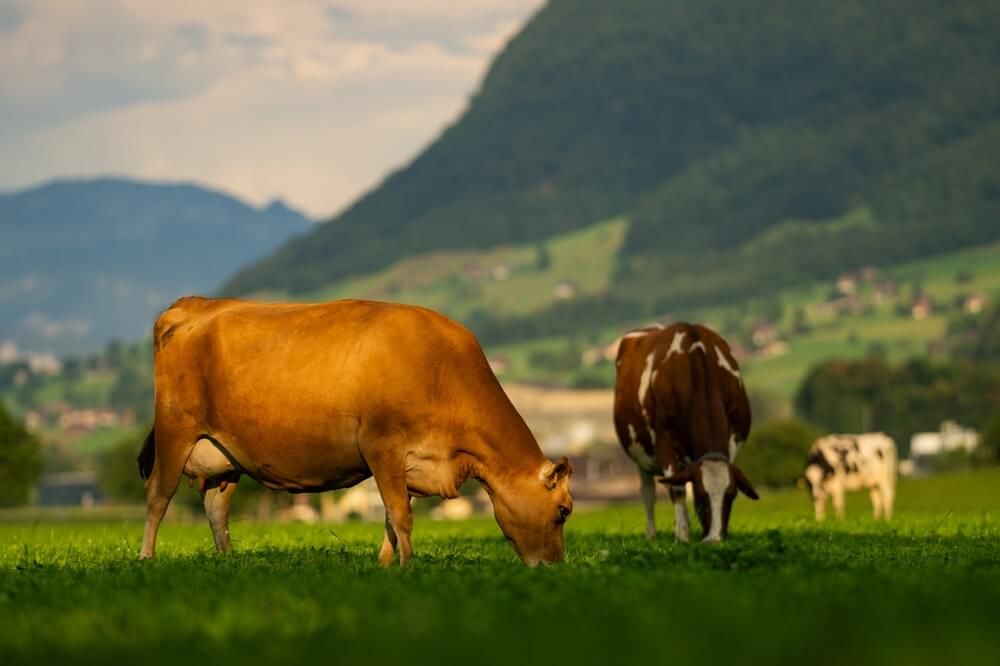
Sound good?
Let’s begin!
What’s Inside:
What Do Cows Eat?
Cows do, indeed, eat grass. Their diets consist mainly of roughage from various grasses, hay, legumes, and silage. Grass pastures also provide much of the protein they require, although lactating dairy cows may need additional protein supplements. Minerals, salt, and plenty of fresh water are also essential.
Being large animals, cows naturally have big appetites. The average cow eats around 2% of its body weight every day. That equates to between 24 to 45 pounds of grass per day.
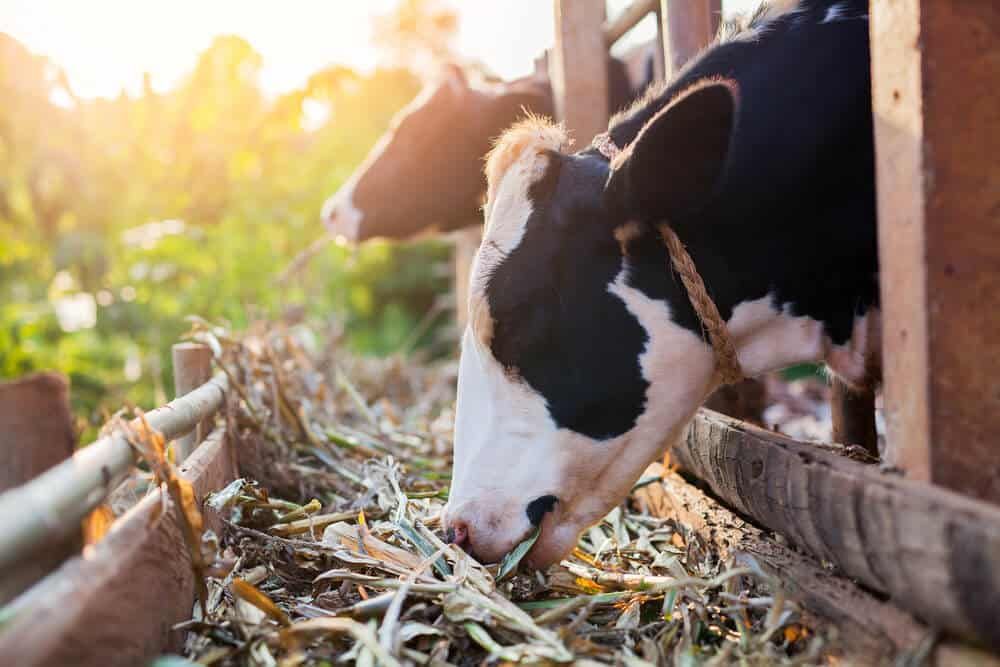
Why and How Do Cows Eat Grass?
Cows have very few teeth compared to other herbivores and therefore have a different approach to grazing.
Instead of using its front incisors to tear through the grass, a cow uses its tongue, wrapping it around a clump of grass before biting it off. The cow then uses a side-to-side jaw motion that enables them to shred the grass into digestible pieces.
Unlike humans, who have just one stomach and generally believe that one’s too big, cows have four, each of which has a different role in the digestive process.
The most significant section of the stomach is the rumen. The rumen of a mature cow is around the same size as a 55-gallon drum or trash can.
The rumen operates like a giant food processor, using microorganisms and bacteria to break down the digested food.
Their massive tummy enables the cow to digest foodstuffs, like plant matter that we find indigestible. As they chew (ruminate) their cud, they extract nutrients that would not be available to other animals.
Although both beef and dairy cows can get many nutrients from grass, the type and quality of that roughage will affect their other dietary requirements.
Best Practices for Feeding Cows
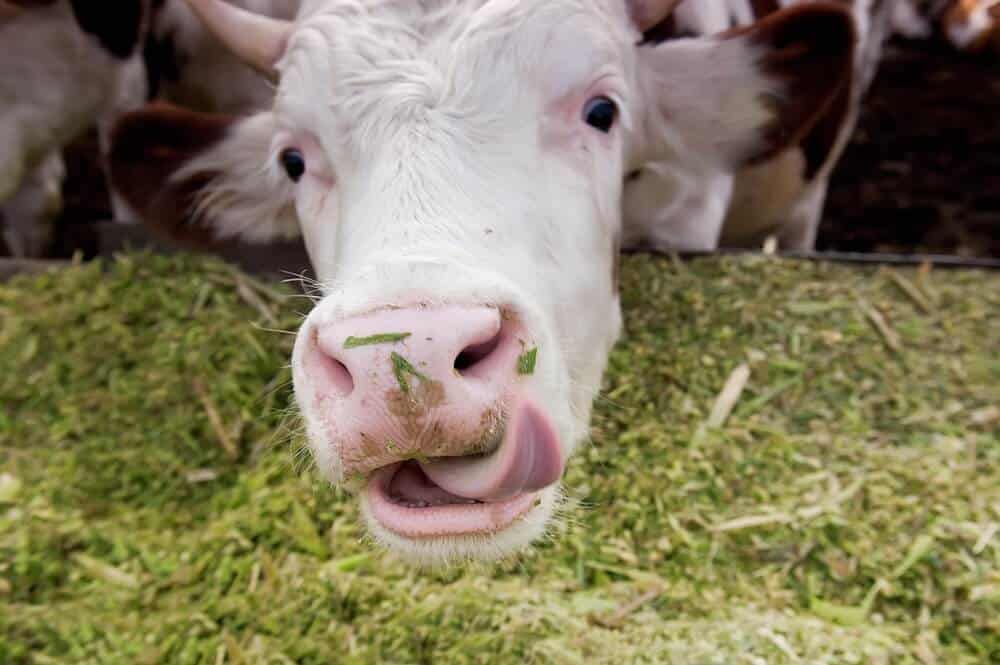
We know that raising and feeding cows are tricky topics for new homesteaders and farmers!
We’re sharing some of our best insights below – and we also want to answer what cows eat in more detail.
Why Cows Need Pasture and Forage
Good-quality pasture can give your cows all the nutrients and protein they need. It’s the most cost-effective way of feeding a cow but requires careful monitoring and maintenance if you wish for it to maintain its nutritional density year after year.
What is the Best Grass for Cows to Eat?
The ideal beef pasture is something of a salad bar for cows. Containing many plants and grasses, a beef pasture of this nature gives the cows an element of nutritional diversity while increasing the soil fertility.
A traditional pasture mix might contain alfalfa, ryegrass, fescue, and orchard grass. You can also add so-called weeds, like clover and dandelion, to boost the protein content and the flavor.
Read more about whether cows can eat clover here.
How Much Grass Does a Cow Eat Per Day?
A cow needs to eat around 2.5% to 3% of its body weight in grass daily. A mature beef cow that weighs approximately 1,210 pounds requires roughly 30 to 35 pounds of pasture a day.
For large mature dairy cows, like a Holstein, which weighs 1,500 pounds, it increases to around 45 pounds.
We also advise consulting with a trusted veterinarian or cattle nutritionist. Ask to ensure that your calves and cattle get the nutrients they need.
Why Do Cows Need Hay?
During the winter, when pasture is limited, cattle need supplementary feed in the form of hay. The daily hay requirements depend on its production stage, age, and size.
While high-quality mixed cattle hay is ideal for beef cattle, lactating dairy cows require a higher protein intake, making alfalfa a more appropriate choice.
What Do Cows Eat Other than Grass?
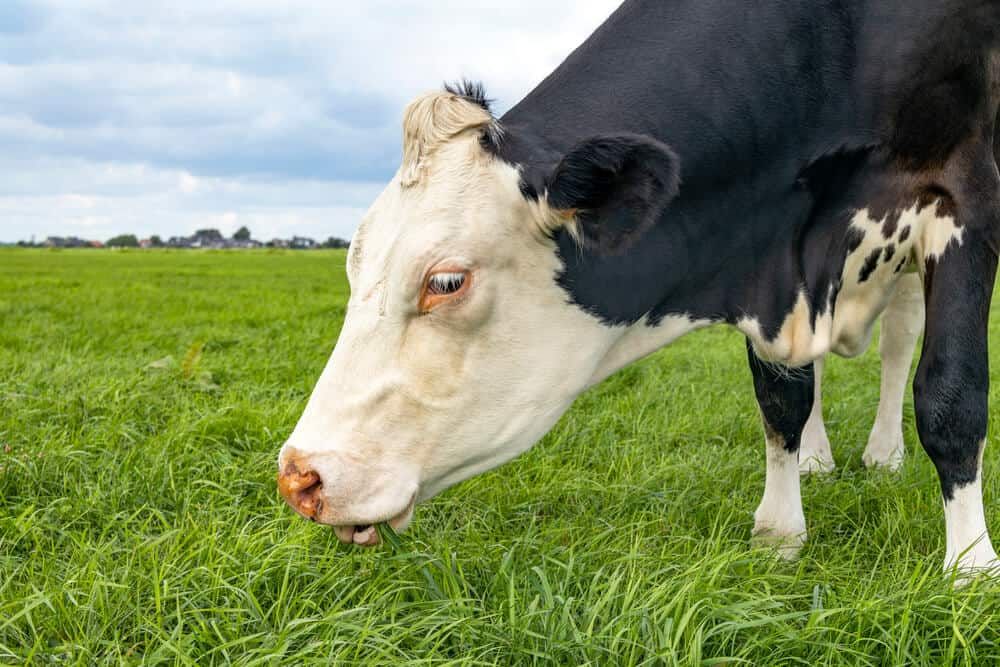
Most grain feeds for cows contain a mixture of ground corn, oats, wheat bran, and soybean oil meal or linseed meal. Some supplements are available that provide vital nutrients to the beef cow and increase protein uptake in dairy cows.
Grain supplementation can increase a dairy cow’s productivity and give a young heifer the protein she needs to develop to her full potential.
However, the best food for a dairy cow isn’t always the same as for a beef cow. Dairy cows need lots of protein to fuel their milk production and benefit from a high-energy total mixed feed. But the same diet might cause bloat in a beef cow.
Cows also happily eat vegetables and fruit – apples, for example!
What Do Bulls Eat?
As bulls and cows belong to the same species, they enjoy the same type of meals. Bulls love dining on mixed pastures comprised of alfalfa, bermudagrass, ryegrass, and other forage. During the winter, when forage decreases, bulls need supplemental cattle feed. Or hay.
Read More – How Much Do Hungry Cows Eat During Winter? This Much!
If your beef cattle or dairy cattle herd contains a group of picky eaters, or if you feel that your cows need better nutrition, check out the TruCare trace mineral blend. It is a blend to help supplement your cow's skin, coat, hoofs, digestion, and reproduction system. It contains copper - so do not give it to your sheep!
What Do Cows Eat? – FAQs
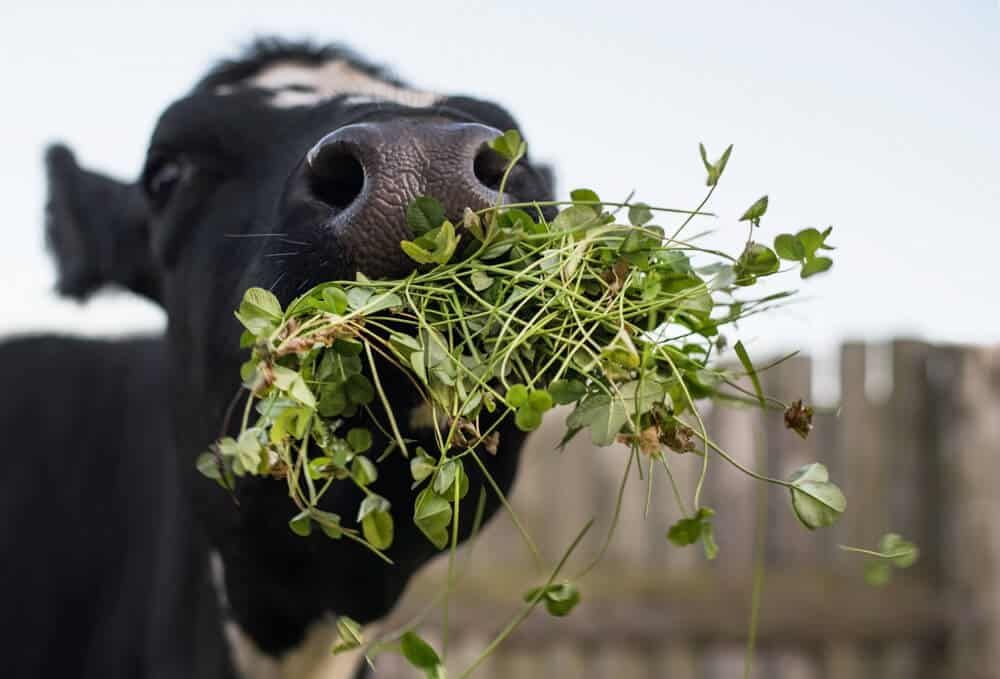
What do cows eat? It seems like they’re much pickier eaters than they should be!
So – we’re answering some of the top FAQs regarding what cows love to eat – and what they despise.
We hope these answers help your herd!
Cattle usually eat a combination of roughage and concentrates, but the list doesn’t end there. Dairy cattle in the US get fed a bizarre array of leftover feedstuffs, ranging from stale doughnuts to gummy bears.
Many homesteaders supplement their cow’s diets with garden vegetables, including beets, carrots, kale, squash, and turnips.
I’ve witnessed rural cows in South Africa happily munching on plastic bags and electric cables, so I know of very little they’ll turn their noses up at, even if it isn’t very nutritional!
Commercial cattle operations rely on food-processing by-products to boost the diet. Food products include potato peels, nut and seed hulls, fruit pulp, sugar beet pulp, and silage by-products.
Some commercial cows have a weird and wild diet. Who can forget the story about the truckload of Skittles that scattered cargo on the way to a cattle farm in Wisconsin?
Many farmers rely on rejected candies and baked produce to reduce their feed costs while maintaining their cow’s condition. It may sound weird, but experts, including John Waller from the University of Tennessee, believe it’s a viable (diet).
(We don’t judge!)
Skittle Truckload: https://www.cnn.com/2017/01/19/health/spilled-skittles-road-trnd/index.html
More Spilled Skittles: https://edition.cnn.com/2017/01/19/health/spilled-skittles-road-trnd
Grass, hay, and corn. But it doesn’t end there! Cows also love to munch on leftover fruits and veggies – and extra garden crops make excellent treats to help supplement a (hopefully) thick and diverse pasture.
High-quality grasses or hay can give a cow all the nutrition it needs. During the cold winter months, forages become scarce. So during winter – dietary supplements and a total mixed ration (TMR) will help nourish and sustain your herd.
Yes, cows go so batty over a bucket of fruit! They could be considered fruit bats. They’ll greedily munch their way through a bag of apples, several bunches of bananas, and even a pile of pineapples.
It’s safe for cows to eat almost any fruit, assuming you don’t mind sharing your summer harvest with them. The only dangerous fruits to cows are cherries and apricots. They both contain high levels of cyanide.
They love the taste and can’t help but eat grass – and many other forage crops! Cows are ruminants and, as such, have the necessary digestive system to extract nutrients from plant matter, such as grass.
Cows use their tongues to rip off a clump of grass, which they then ground into digestible pieces using their molars and curious side-to-side chewing motion. The grass then passes into the cow’s rumen, where it feeds the cow’s bacteria which, in turn, feeds the cow.
We love these all-natural Himalayan salt licks. We think your cattle, horses, sheep, and goats will enjoy them too! The salt lick weighs between four to six pounds. It's natural rock salt - and not pressed salt. It has no additives or preservatives, only trace minerals like magnesium, calcium, and potassium.
Conclusion
Cows eat many things in addition to grass. In the ideal scenario, the cows on any homestead would have access to mixed grass pasture, some homegrown fruit and vegetables, and a grain supplement that compensates for any mineral deficiencies in their roughage.
Although dairy and beef cattle have slightly different dietary requirements, they both need good-quality grazing or roughage to maintain a healthy weight. Dairy cows need extra protein to boost their milk production. But beef cattle can thrive on a more simple and slightly cheaper diet.
What about you?
What do your cows eat? Do you have stories about fruits and veggies or other weird things that your cows love to snack on and devour?
If so – we’d love to hear your stories!
Thanks so much for reading.
Have an excellent day!
Read More – 275+ Cute and Funny Cow Names! Perfect for Your Entire Herd!

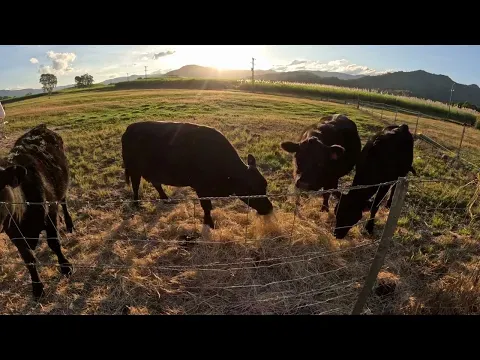
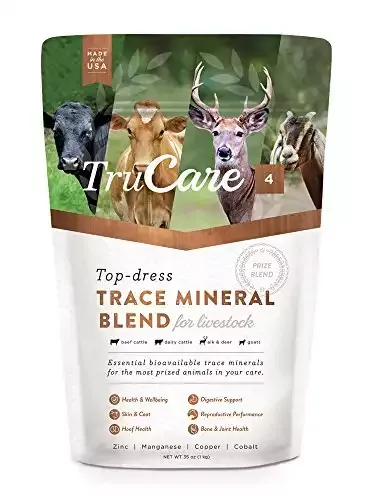
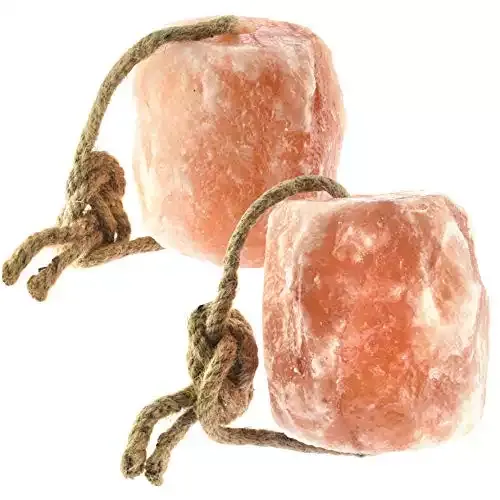

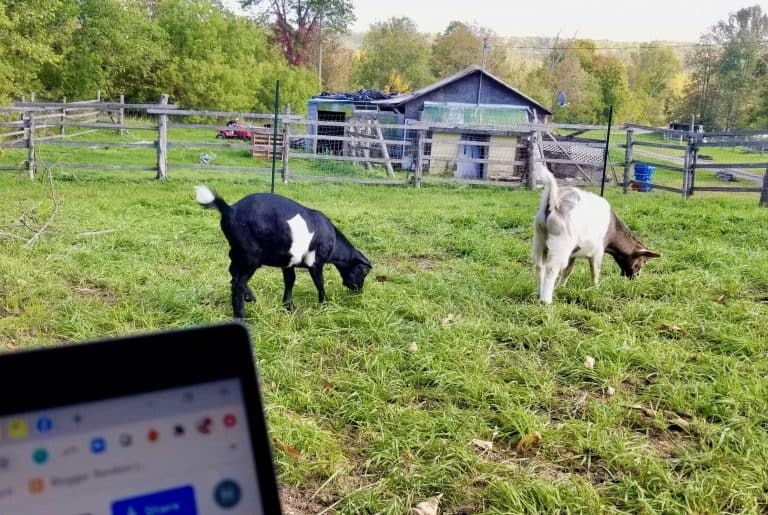
![17 Goat Toys Ideas to DIY, Upcycle, and Buy [With Super Cute Videos!]](https://69be7209.flyingcdn.com/wp-content/uploads/2020/09/girl-is-playing-with-little-goat-on-the-farm-768x510.jpg)
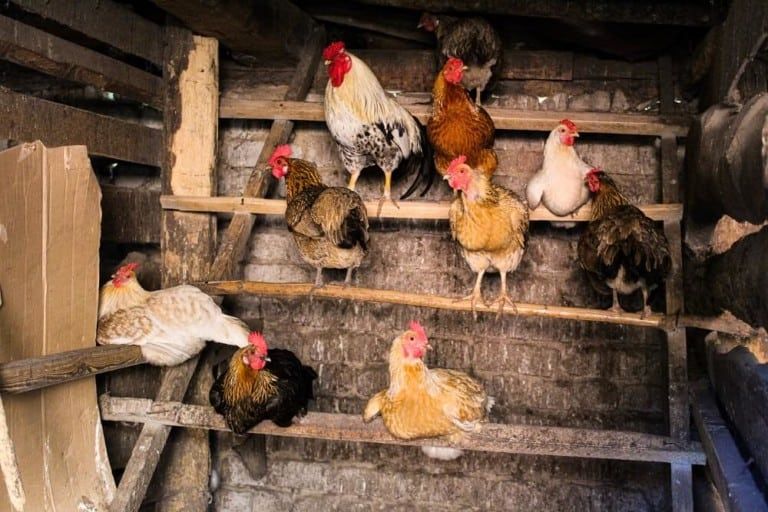
![How Much Meat Is Half a Cow? [Weight, Cost, and Storage Guide!]](https://69be7209.flyingcdn.com/wp-content/uploads/2022/12/beef-cows-and-calves-grazing-on-pasture-on-australian-ranch-768x512.jpg)
